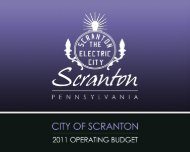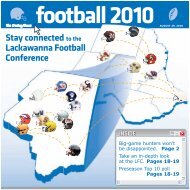racetracks
I want to be left alone! - The Times-Tribune
I want to be left alone! - The Times-Tribune
- No tags were found...
Create successful ePaper yourself
Turn your PDF publications into a flip-book with our unique Google optimized e-Paper software.
Poll: economic frailty may result in ‘political mayhem’<br />
Consumer confidence falters<br />
By Dennis Jacobe<br />
In a session with the House Financial<br />
Services Committee, Federal Reserve<br />
Chairman Alan Greenspan optimistically<br />
stated that the U.S. economy is “at a turning<br />
point,” and predicted that low interest<br />
rates, increasing stock prices, and the<br />
effects of the new tax cut would spur<br />
economic growth.<br />
Later it was reported that the University<br />
of Michigan’s preliminary consumer sentiment<br />
index rose in early July from its final<br />
June reading. Not surprisingly, many analysts<br />
noted that the increase was due to the<br />
same factors cited by Greenspan earlier.<br />
In sharp contrast, a July 7-9 Gallup<br />
Tuesday Briefing Poll* shows just the<br />
opposite.The June rise in consumer optimism<br />
about the economy did not continue<br />
to build in July.The percentage of<br />
American consumers rating economic<br />
conditions as “good” or “excellent”<br />
decreased slightly between June and July,<br />
and consumers are slightly more likely to<br />
say that economic conditions are getting<br />
worse than to say they are getting better.<br />
The public gave a similarly tepid<br />
response when asked about its expectations<br />
for economic growth, interest rates,<br />
and inflation over the next six months.<br />
Fewer Consumers Expect Increased<br />
Economic Growth<br />
The percentage of consumers expecting<br />
economic growth to increase over the<br />
next six months declined from 54 percent<br />
in June to 49 percent in July, while<br />
the percentage of those expecting<br />
growth to decrease rose from 20 percent<br />
to 22 percent.<br />
Thus, the differential between those<br />
expecting an increase in economic<br />
growth and those expecting a decrease<br />
fell from +34 percent in June to +27<br />
percent in July.<br />
Consumer expectations for increasing economic<br />
growth are now about where they<br />
were in April 2003 (+29 differential).<br />
Currently, consumer expectations are much<br />
better than they were in January 2003 (+16<br />
differential) and October 2001 (+5 differential),<br />
but well below where they were in<br />
March 2002 (+43 differential).<br />
Still, Consumers’ Interest Rate<br />
Expectations Are About the Same…<br />
The percentage of consumers expecting<br />
the interest rates to increase over the next<br />
six months declined from 43 percent in<br />
June to 41 percent in July.At the same<br />
time, the percentage of consumers expecting<br />
rates to go down also declined from 20<br />
percent in June to 17 percent in July. So<br />
the differential between those expecting<br />
rates to go up and those expecting them to<br />
go down was virtually unchanged — +23<br />
in June and +24 in July.<br />
Right now, substantially fewer consumers<br />
expect interest rates to increase<br />
in the months ahead than was the case in<br />
April 2002, when 59 percent expected<br />
rates to increase and the differential was<br />
+45. On the other hand, far fewer<br />
Americans expect rates to decline now<br />
than in October 2001, when 25 percent<br />
expected rates to increase and the differential<br />
was -19.<br />
. . . As Are Consumer Inflation<br />
Expectations<br />
According to the July Gallup Tuesday<br />
Briefing poll, 48 percent of consumers<br />
expect inflation to accelerate in the next<br />
six months.This percentage is the same as<br />
it was in June, although the inflation<br />
expectations differential increased from<br />
+32 in June to +35 in July.At present, consumer<br />
inflation expectations are not as<br />
great as they were a year ago when the<br />
differential was +45, but the differential is<br />
above its October 2001 level of +27.<br />
Consumer Growth Expectations Are<br />
Extremely Fragile<br />
The failure of consumer expectations to<br />
gain additional positive momentum in<br />
July is troubling.As the Fed and the analyst<br />
community have argued, fiscal and<br />
monetary policies are now highly stimulative.<br />
Investors showed great enthusiasm<br />
in June — maybe even a little too much<br />
— and virtually every economic forecaster<br />
expects economic growth to improve<br />
in the months ahead.<br />
Still, contrary to what some observers<br />
see in the University of Michigan’s preliminary<br />
report, Gallup Tuesday Briefing’s<br />
data does not support the idea that consumers<br />
or business decision-makers are<br />
convinced, at least at this point.<br />
In essence, recent economic crosscurrents<br />
have made today’s consumer expectations<br />
extremely fragile.The hope is that<br />
we are experiencing a lag between the<br />
implementation and the positive impact<br />
on consumer perceptions of the recent<br />
A Clear View to the Future.<br />
When we first opened our doors back in 1930, our business revolved around<br />
replacing glass in automobiles. Today, our family owned business has grown<br />
to become the area’s premier full service glass company.<br />
We have supplied the doors, windows and hardware for some of Eastern<br />
Pennsylvania’s most recognizable buildings. Whether it’s universities,<br />
retail stores, or family restaurants, when area businesses want to expand,<br />
remodel, or just replace, they look to Mesko Glass.<br />
What has not changed is that we take care of your needs, no matter the size<br />
of your business.<br />
• Store Fronts<br />
• Plate Glass Replacements<br />
• Solariums, Vestibules<br />
& Patio Rooms<br />
• Mirror Design & Installation<br />
• 24-Hour Emergency Service<br />
• Glazing Contractors<br />
• Smoking Enclosures<br />
•Window Retrofit Packages<br />
• Builders Hardware Services<br />
• Design & Build Capabilities<br />
• Aluminum & Steel<br />
Doors & Frames<br />
Over 70 years of quality, service and selection<br />
Call us today! 1-800-982-4055<br />
economic stimuli.Tax-cut checks and<br />
withholding changes don’t even begin to<br />
take place until late this month, and<br />
lower interest rates can take four to six<br />
months to have an impact.<br />
With any luck, consumer optimism —<br />
and even business optimism — will build<br />
in the months ahead and we’ll see a surge<br />
in consumer/business optimism and a<br />
much stronger economy later this year<br />
and into 2004.<br />
If not, today’s economic fragility may<br />
well translate into political mayhem as<br />
both major parties recognize that next<br />
year’s elections could be very difficult for<br />
many of today’s officeholders.<br />
*Results are based on telephone interviews<br />
with 1,006 national adults, aged 18 and<br />
older, conducted July 7- 9, 2003.For results<br />
based on these total samples, one can say<br />
with 95 percent confidence that the margin<br />
of sampling error is ±3 percent.<br />
Middle market firms, citing<br />
improving economy, vow to<br />
invest in technology<br />
From competition within the middle<br />
market to vying with larger competitors<br />
and new companies entering the market,<br />
middle-market business leaders are feeling<br />
the pinch of a heightened competitive<br />
environment, according to findings<br />
from the Grant Thornton Survey of<br />
Middle-Market Business Leaders.<br />
Ninety-four percent cite competition as<br />
more intense or as intense as one year<br />
ago, while just 6 percent say the competitive<br />
environment is less intense.<br />
“As the market has tightened, so, too,<br />
have the competitive pressures on middle-market<br />
companies,” says John<br />
Desmond, partner in charge of the<br />
Business Leaders Council.“Companies,<br />
especially those in the middle-market, are<br />
not only fighting for new business —<br />
often at lower margins — but many are<br />
also looking for new ways to keep existing<br />
customers from taking their business<br />
to the competition.”<br />
Additional survey highlights:<br />
Survey respondents cited a greater<br />
focus on price (89 percent), more knowledgeable<br />
customers (82 percent), and<br />
less client loyalty (81 percent) as the top<br />
business issues related to competition.<br />
Two-thirds (74 percent) of middle-market<br />
business leaders believe it is more<br />
important today for employees to understand<br />
what needs to be done for the<br />
company to succeed.<br />
To enhance employee alignment and<br />
motivation, 82 percent are focusing on<br />
consistent communications, and 81 percent<br />
are establishing realistic expectations<br />
for employee performance.<br />
Fifty-two percent of respondents are<br />
taking immediate steps to better allocate<br />
resources by deselection — focusing<br />
exclusively on initiatives that will be<br />
most profitable.<br />
In preparation for an improved business<br />
climate, 84 percent of middle-market<br />
business leaders have — or plan to<br />
— invest in new technology (58 percent<br />
and 26 percent, respectively).<br />
The Summer 2003 Survey of Middle-<br />
Market Business Leaders, with a special<br />
emphasis on how companies are positioning<br />
for an improved economy, is now available.To<br />
order a printed or .pdf version of<br />
the report, visit Grant Thornton’s Web site<br />
at www.grantthornton.com/blcsurvey.<br />
22 • NORTHEAST PENNSYLVANIA BUSINESS JOURNAL • SEPTEMBER 2003




